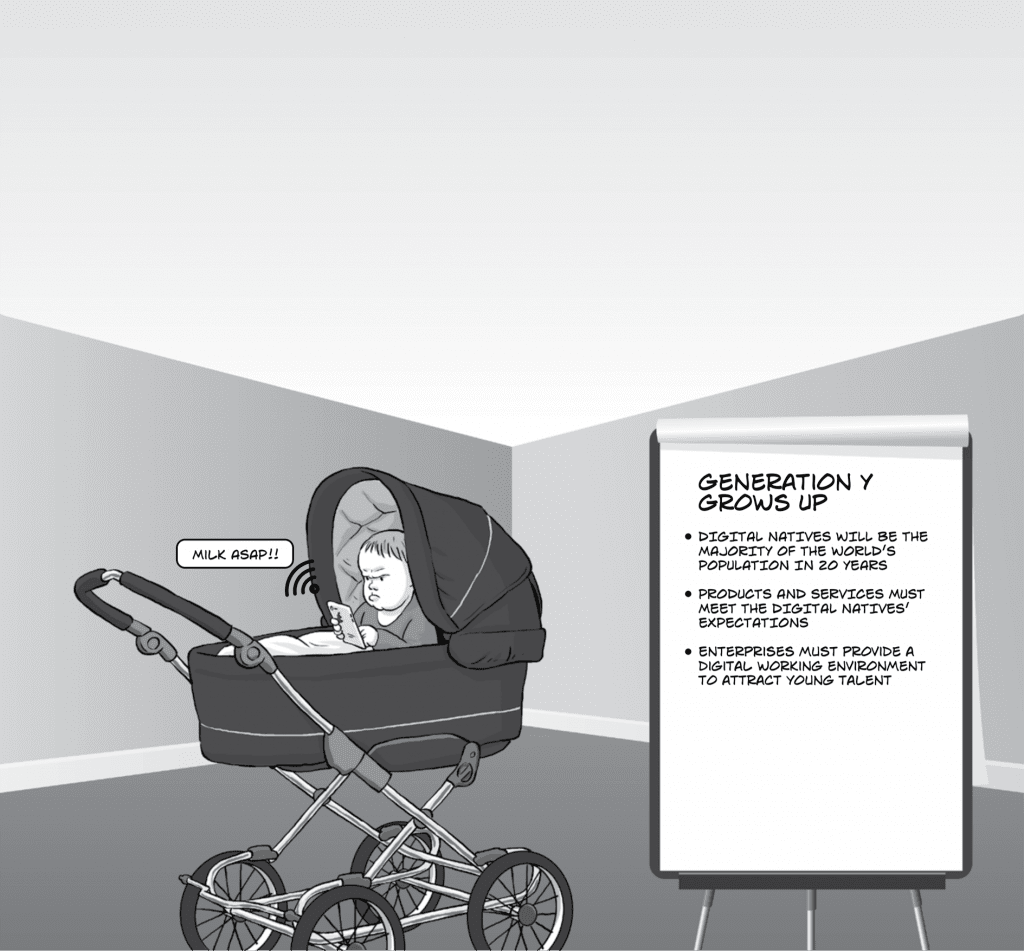In the previous sections we have discussed the fact that customers, employees and partners have adopted digital services. More and more people are not only able to handle digital services, but they also expect digital tools to be available and anticipate their ease of use and responsiveness – these technologies are core to their day-to-day life. The rapid adoption of new and existing digital tools will continue to increase, given the fast pace of technology and the awareness that technology-savvy generations have already grown up with. According to the general definition, the so-called ‘Generation Y’ was born between 1980 and 1995, meaning that today they are already aged between 21 and 36.[1] These adults are expecting their employers, their service providers and their private surroundings to manage digitalisation by being able to offer digital tools for communication purposes, for processing services, and to simplify everyday actions.
Beyond this demographic group, the next generation is already growing up named ‘Generation Z’, or more precisely ‘Millennials’ born around 1995–2000.[2] Today, already aged between 16 and 21, they grew up with digital services. In contrast to Generation Y, they have not experienced previous technological transformations such as the implementation of the Internet in the nineties, the replacement of mobile phones with smartphones, or the fall of video, DVD and CD providers, which were replaced by disrupting business models offering online streaming services.
The huge difference, which must be understood, is that Generation Z does not know the ‘old world’; they have grown up in a digital, technology-driven environment, in which most daily actions are handled with digital support, starting by brushing their teeth with a toothbrush linked via an app, training for a job via e-learning, and ending the day by listening to streamed audio books while falling asleep.
Many examples can easily be cited where these teenagers do not even know about non-digital solutions. For example, they are unlikely to search on conventional paper-based maps to locate the position of their parents, because they are not familiar with these non-digital devices. Generations Y and Z think of finding solutions in digital terms and, as the figure on the following page indicates,[3] they already significantly outnumber the population born before 1980.

Obviously, the handling of digital tools (i.e., online search engines, messaging, online assistants, apps and new entertainment offerings) are intuitive and natural for them, meaning that their behaviour and consequently, their social values are simultaneously changing on the basis of new technological opportunities. A further characteristic of Generations Y and Z is their new social culture. They are more extrovert and willing to share data via apps if they benefit from it (e.g., obtaining more personalised solutions), which increases their willingness to reveal sensitive information. Even in the restrictive German healthcare sector the mindset is changing. Stakeholders in this system are having to accept the empowerment of patients based upon greater transparency provided by online communities, comparison portals for healthcare services, and information provided via the Internet through the use of self-tracking healthcare apps in combination with wearable technology.[4] A further cultural aspect is that prestige objects and physical payment methods are not that important for Generations Y and Z. This illustrates that they are becoming independent of brands, possessions and showpieces and are evolving towards focusing on the effectiveness and ease of access of services, which promise to bring flexibility and financial benefits.[5]
For companies, these shifts towards digitalisation mean that a notable proportion of their customers expect the conversion of formerly conventional services into digital products and services, with the addition of new value-added components.
Not only customers have new requirements; both new entrants to the workforce and experienced employees expect a digital environment.
Employers offering a digital working environment have a significant competitive advantage in the job market with respect to recruitment of the most talented employees.
Instead of work-life balance, new generations prefer work-life integration, which means they prefer working in a stimulating, flexible environment.[6] Companies have to satisfy young employees’ expectations in order to attract and retain them. They will then benefit from the new generations’ knowledge and ways of working, being a group who better understand and adapt quickly to upcoming trends and new ways of thinking. It is therefore a must for enterprises looking to preserve or enhance their international competitiveness to promote workforce effectiveness by providing a digital working environment and offering new work models in response to interconnected digital lifestyle trends.[7]
It is essential for companies to rapidly detect new trends in technology and combine them with trends in society at large, for example the requirement to remain anonymous and at the same time consume real-time information. Snapchat captured this trend and became one of the most popular social media channels.[8]
In addition, companies should try to win over the most innovative digital employees to develop the services and products of tomorrow. A modern workplace, in the sense of simplifying day-to-day processes, is essential as it frees more working time for exploring innovative ideas to establish drivers of innovation, resulting in the ability to become a thought leader. Companies should proactively focus on adopting flexible working hour models and nurture international, multi-disciplinary and collaborative teams that work together in digital team rooms, engaging with customers in the product development process. Unconventional workplaces can also be helpful in enhancing innovation. Examples include office areas that contain climbing walls, an office Zen garden cared for by the office team and the ‘work-life balance by design’ trend (say, desks that can be retracted up to the ceiling after 6 p.m. for the purpose of making room for creative time in the office community).
A mix of unconventional approaches, a bold ‘trial and error’ culture and an agile organisation will become mandatory for companies determined to become and remain winners in the digital age.
_____
[1] Bund, K.: ‘Glück schlägt Geld. Generation Y: Was wir wirklich wollen’, Murmann, 2014.
[2] Strauss, W., Howe N.: ‘Millennials Rising: The Next Great Generation’, Vintage, 3rd ed., 2000.
[3] CIA World Factbook: ‘World Age structure’, IndexMundi, 2016.
[4] Biesdorf, S., Niedermann, F.: ‘McKinsey Digital Patient Survey 2014’, McKinsey, 2014.
[5] Rook, D.: ‘Benefits That Matter Most, Part One: The Millennial Mindset’, JPGriffn Group, 2015
[6] Wen, C.: ‘The Millennial Pace of the Digital Workplace’, LiveTiles, 2016.
[7] Gotta, M., Cain, M. W.: ‘Digital Workplace Key Initiative Overview’, Gartner, 2014.
[8] Trefs Team: ‘Is Snapchat Threatening Twitter?’, Forbes, 2016.

